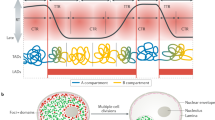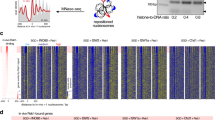Abstract
POSITIONING of nucleosomes has been proposed as one mechaná-ism whereby the activity of DNA is regulated: cis-acting elements located in linker DNA might be more accessible for interaction with trans-acting protein factors than they would be if they were directly associated with histones in nucleosome core particles. The eleven base pairs constituting the autonomously replicating sequence (ARS)1 of the high-copy-number TRP1ARS1 plasmid of Saccharomyces cerevisiae are located in a linker region near the edge of a positioned nucleosome2 and form an origin of replication3. Could nucleosome positioning render the ARS accessible for interaction with the proteins necessary for its function? I have tested this hypothesis by making deletions and an insertion to move the ARS into the nucleosome DNA and then examining the effects on ARS function. There is a marked decrease in copy number when the ARS is moved into the central DNA region of the nucleosome core particle, a region known to differ in structure and stability from the peripheral segments of nucleosome DNA.
This is a preview of subscription content, access via your institution
Access options
Subscribe to this journal
Receive 51 print issues and online access
$199.00 per year
only $3.90 per issue
Buy this article
- Purchase on Springer Link
- Instant access to full article PDF
Prices may be subject to local taxes which are calculated during checkout
Similar content being viewed by others
References
Struhl, K., Stinchcomb, D. T., Scherer, S. & Davis, R. W. Proc. natn. Acad. Sci. U.S.A. 76, 1035–1039 (1979).
Thoma, F., Bergman, L. W. & Simpson, R. T. J. molec. Biol. 177, 715–733 (1984).
Brewer, B. J. & Fangman, W. L. Cell 51, 463–471 (1987).
Campbell, J. L. A. Rev. Biochem. 55, 733–771 (1986).
Campbell, J. L. Trends Biochem. Sci. 13, 212–217 (1988).
Umek, R. M., Linskens, M. H. K., Kowalski, D. & Huberman, J. L. Biochem. biophys. Acta 1007, 1–14 (1989).
Srienc, F., Bailey, J. E. & Campbell, J. L. Molec. cell. Biol. 5, 1676–1684 (1985).
Snyder, M., Buchanan, A. R. & Davis, R. W. Nature 324, 87–89 (1986).
Celniker, S. E., Sweder, K. S., Srienc, F., Bailey, J. E. & Campbell, J. L. Molec. cell. Biol. 4, 2455–2466 (1984).
Jayram, M., Sutton, A. & Broach, J. R. Molec. cell. Biol. 5, 2466–2475 (1985).
Hill, A. & Bloom, K. Molec. cell. Biol. 7, 2397–2405 (1987).
Wilson, K. L. & Herskowitz, I. Proc. natn. Acad. Sci. U.S.A. 83, 2536–2540 (1986).
Weischet, W. D., Tatchell, K., van Holde, K. E. & Klump, H. Nucleic Acids Res. 5, 138–160 (1978).
Simpson, R. T. J. biol. Chem. 254, 10123–10127 (1979).
Lee, K., Baxter, H. J., Guillemette, J. G., Lawford, H. G. & Lewis, P. N. Can. J. Biochem. 60, 379–388 (1982).
Morse, R. H., Pederson, D. S., Dean, A. & Simpson, R. T. Nucleic Acids Res. 15, 10311–10330 (1987).
Richmond, T. J., Finch, J. T., Rushton, B., Rhodes, D. & Klug, A. Nature 311, 532–537 (1984).
Rhodes, D. EMBO J. 4, 3473–3482 (1985).
Perlmann, T. & Wrange, O. EMBO J. 7, 3073–3079 (1988).
Richard-Foy, H. & Hager, G. L. EMBO J. 6, 2321–2328 (1987).
Almer, A., Rudolph, H., Hinnen, A. & Horz, W. EMBO J. 5, 2689–2696 (1986).
Church, G. M. & Gilbert, W. Proc. natn. Acad. Sci. U.S.A. 81, 1991–1995 (1984).
Author information
Authors and Affiliations
Rights and permissions
About this article
Cite this article
Simpson, R. Nucleosome positioning can affect the function of a cis-acting DMA elementin vivo. Nature 343, 387–389 (1990). https://doi.org/10.1038/343387a0
Received:
Accepted:
Issue Date:
DOI: https://doi.org/10.1038/343387a0
This article is cited by
-
Lola-I is a promoter pioneer factor that establishes de novo Pol II pausing during development
Nature Communications (2023)
-
Construction of a transposase accessible chromatin landscape reveals chromatin state of repeat elements and potential causal variant for complex traits in pigs
Journal of Animal Science and Biotechnology (2022)
-
Nucleosome-directed replication origin licensing independent of a consensus DNA sequence
Nature Communications (2022)
-
Humanizing the yeast origin recognition complex
Nature Communications (2021)
-
Well-positioned nucleosomes punctuate polycistronic pol II transcription units and flank silent VSG gene arrays in Trypanosoma brucei
Epigenetics & Chromatin (2017)
Comments
By submitting a comment you agree to abide by our Terms and Community Guidelines. If you find something abusive or that does not comply with our terms or guidelines please flag it as inappropriate.



